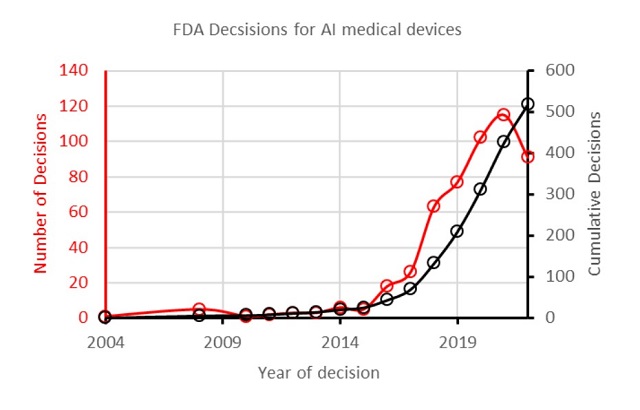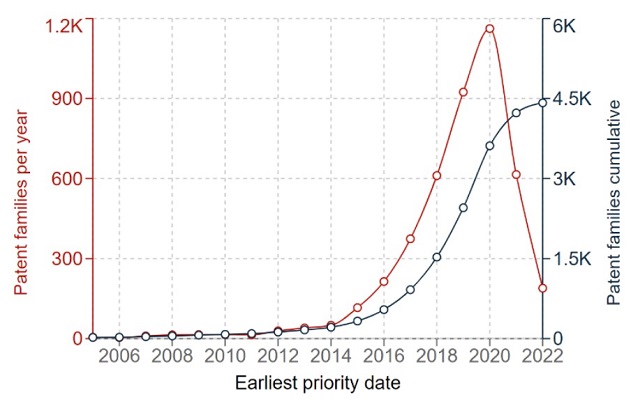As part of a wider overhaul of medical device regulation in the UK, the UK government recently published a roadmap for patient-centric regulation of software, including AI, as a medical device. This is in line with the sector-specific approach envisioned by the UK government for regulating AI technology in an innovation friendly way. With all that in mind, I asked myself what the innovation landscape looks like for AI medical devices. Looking around, I came across this dataset of FDA decisions on AI medical devices since 1995. Of course, I could not resist taken a look at the data.

Looking at the overall trend of final decisions on AI medical devices (which should be a good proxy for approval applications and market activity), it is noticeable that there is an inflection point in 2016 when the number of decisions went from low single digits to around 20 and then 60 and more a year with an ever-accelerating rate. For 2021, the last full year of data there were close to 120 decisions and this year's data looks like it won't lag behind). These numbers follow the trend seen in priority dates for patent families in this space (on which more below) and tallies broadly with the general trends in commercialisation of AI technology on a similar time frame.
So, what fields of technology are driving this trend? Of the 521 decisions since 1995, 75%, relate to radiology, for example aids for the interpretation or triage of medical images, followed by cardiovascular applications (11%), such as monitoring of ECG signals. The remainder is made up by a long tail including haematology (3%), neurology (3%), ophthalmic (1%) and clinical chemistry (1%), with the remainder split between fields such as plastic surgery, anaesthesiology, and pathology. As far as one can tell from the small numbers involved in most fields, there is no particular shift amongst the technologies, with radiology applications being dominant from the inflection point in 2016.

How does this stack up against patenting trends. As mentioned, the overall trend of an inflection point and strong growth since 2016 or so is also reflected in the patent data. To get an idea of patent filings in this area, I looked at patent families classified in both CPC classification G16H50 (ICT specially adapted for medical diagnosis, medical simulation, or medical data mining; ICT specially adapted for detecting, monitoring, or modelling epidemics or pandemics) and G06N20 (machine learning). Looking at this data, while the general shape of the trend is the same, there are many more patent filings than FDA decisions. Why is that? Recalling that most of the FDA decisions related to radiology, I added some keywords relating to medical imaging to my search (any of "radiology x-ray ct mri ultrasound tomography" OR "medical imag*" OR "magnetic resonance"). This returned about 850 hits (and a very similar shape of curve for numbers filed each year), much more in line with the number of FDA decisions. So, it seems that while commercialisation of medical devices (as judged by FDA decisions at least) is heavily focussed on radiology applications, there is much innovation in other fields that could give rise to AI medical devices. Looking through the main CPC sub-classes of the non-radiology patent filings, the majority of these relate to data mining, risk-assessments, and health indices (e.g., from clinical records and/or measurements), and processing health data. Presumably, if and when these uses of AI mature into commercialised technologies, they will appear more predominantly in future FDA decisions data.
So, what has driven the growth of AI in radiology related medical devices? Part of the explanation is probably that the rise in radiology AI medical devices coincides with the general trend at the time in AI to see successes of applications in image processing more generally, particularly from the use and refinement of Convolutional Neural Networks. Another part may be that radiological exams may well be the most frequent tests patients experience.
In late 2016 Prof Geoffrey Hinton, one of the godfathers of neural networks, said that it's "quite obvious that we should stop training radiologists" as image perception algorithms are very soon going to be demonstrably better than humans. Radiologists are, he said, "the coyote already over the edge of the cliff who hasn't yet looked down". Having studied in the Gatsby Computational Neuroscience Unit when it was headed up by Geoff, I can picture him saying that. Yet, it turns out that radiologists still have jobs and that we now generally take a more cautious approach to the use of AI in medicine (and generally in other practical applications), witness the regulatory efforts mentioned at the beginning of this piece. And for some further reading, here is an article from a NHS radiologist explaining why radiologists are unlikely to queue up at the Job Centre any time soon.
The content of this article is intended to provide a general guide to the subject matter. Specialist advice should be sought about your specific circumstances.

